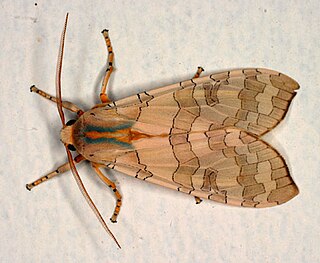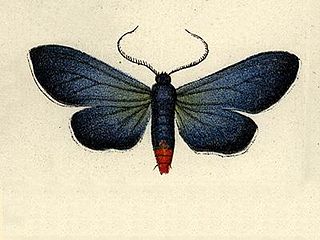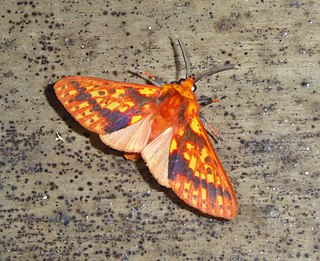Pyrgos or Pyrgus may refer to:
Argyroeides is a genus of moths in the subfamily Arctiinae. The genus was erected by Arthur Gardiner Butler in 1876.

Cisthene is a genus of lichen moths in the family Erebidae. The genus was erected by Francis Walker in 1854.

Cosmosoma is a genus of tiger moths in the subfamily Arctiinae. The genus was erected by Jacob Hübner in 1823.

Cyanopepla is a genus of moths in the subfamily Arctiinae. The genus was erected by James Brackenridge Clemens in 1861.

Eucereon is a genus of tiger moths in the family Erebidae. The genus was erected by Jacob Hübner in 1819.
George Claridge Druce, MA, LLD, JP, FRS, FLS was an English botanist and a Mayor of Oxford.

Iolaus is a genus of butterflies in the family Lycaenidae. The genera Argiolaus, Epamera, Iolaphilus and Stugeta are often included in Iolaus. Iolaus species are found in the Afrotropical realm.

Gymnelia is a genus of moths in the subfamily Arctiinae. The genus was erected by Francis Walker in 1854.

Halysidota is a genus of moths in the family Erebidae. The genus was erected by Jacob Hübner in 1819.

Lepreum or Lepreon, alternately named Lepreus or Lepreos (Λέπρεος) was an Ancient Greek city-state in Triphylia, a district of Elis. It was located 40 stadia away from the sea at the west end of Mount Minthi and built around two citadels. Surrounded by an abundance of natural resources, Lepreum became an important city in the Classical and Hellenistic ages where it became the capital of the Triphylia region. The city has also been identified by some scholars as the mythical city of Aepy, a city described by Homer in the Iliad but never discovered. The ruins of ancient Lepreum have been excavated near the present village Lepreo.
Pseudischnocampa is a genus of moths in the family Erebidae. The genus was described by Rothschild in 1935.

Uranophora is a genus of moths in the family Erebidae. The genus was erected by Jacob Hübner in 1831.

Pseudosphex is a genus of tiger moths in the family Erebidae. The genus was erected by Jacob Hübner in 1818. These moths are mimics of a variety of Hymenoptera. The prefix pseudo means "false", and Sphex is a genus of wasps.
Saurita is a genus of moths in the subfamily Arctiinae. The genus was erected by Gottlieb August Wilhelm Herrich-Schäffer in 1855.

Symphlebia is a genus of moths in the family Erebidae. The genus was erected by Felder in 1874.

Aulacodes is a genus of moths of the family Crambidae. The genus was first described by Achille Guenée in 1854.
Erupa is a genus of moths of the family Crambidae.

Triphylia was an area of the ancient Peloponnese. Strabo and Pausanias both describe Triphylia as part of Elis, and it fell at times under the domination of the city of Elis, but Pausanias claims they reckoned themselves Arcadian, not Elean. They fell under the rule of Elis in the 8th century BC, and remained under Elean rule until the Spartans asserted their control in 402 BC. When the Spartans were defeated by the Thebans at the Battle of Leuctra in 371 BC, the Eleans attempted to reassert their control, but the Triphylians, in order to maintain their independence from Elis, joined the Arcadian League in 368 BC. In this period, their political fortunes were often shared by the areas on the border between Elis and Arcadia but in to the north of the River Alpheus; Xenophon mentions the Amphidolians and Acrorians and the city-states of Lasion, Margana, and Letrini in this context. The Amphidolians, Marganians, and Letrinians are remarkable in Xenophon for fielding slingers for the Peloponnesian army.
Pseudischnocampa nigridorsata is a moth in the family Erebidae. It was described by William Schaus in 1901. It is found in Peru, Argentina and Ecuador.












